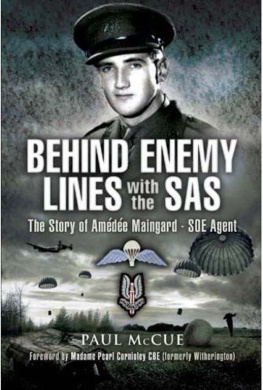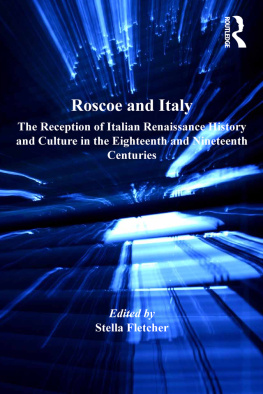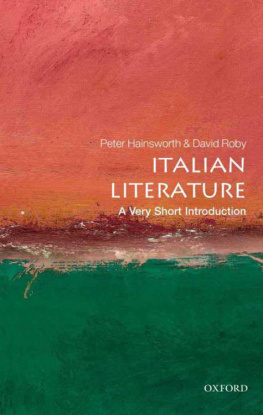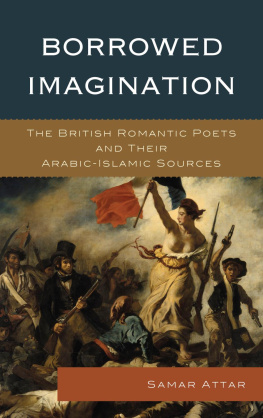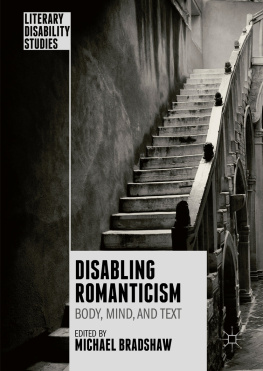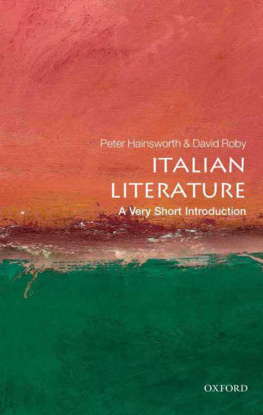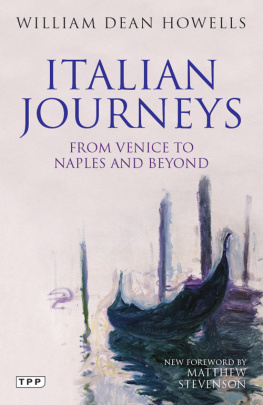BRITISH ROMANTICISM AND THE RECEPTION OF ITALIAN OLD MASTER ART, 17931840
For my family
British Romanticism and the Reception of Italian Old Master Art, 17931840
MAUREEN MCCUE
Bangor University, UK
ASHGATE
Maureen McCue 2014
All rights reserved. No part of this publication may be reproduced, stored in a retrieval system or transmitted in any form or by any means, electronic, mechanical, photocopying, recording or otherwise without the prior permission of the publisher.
Maureen McCue has asserted her right under the Copyright, Designs and Patents Act, 1988, to be identified as the author of this work.
Published by
Ashgate Publishing Limited
Wey Court East
Union Road
Farnham
Surrey, GU9 7PT
England
Ashgate Publishing Company
110 Cherry Street
Suite 3-1
Burlington, VT 05401-3818
USA
www.ashgate.com
British Library Cataloguing in Publication Data
A catalogue record for this book is available from the British Library
The Library of Congress has cataloged the printed edition as follows:
McCue, Maureen.
British Romanticism and the reception of Italian old master art, 17931840/by Maureen McCue.
pages cm.(Studies in art historiography)
Includes bibliographical references and index.
ISBN 978-1-4094-6832-5 (hardcover)ISBN 978-1-4094-6833-2 (ebook)ISBN 978-1-4094-6834-9 (epub) 1. English literature18th centuryHistory and criticism. 2. RomanticismEngland. 3. Art, ItalianInfluence. I. Title.
PR447.M35 2014
820.9145dc23
2014019266
ISBN 9781409468325 (hbk)
ISBN 9781409468332 (ebk-PDF)
ISBN 9781409468349 (ebk-ePUB)
Contents
List of Figures
Acknowledgements
This book began life as my PhD thesis and I am fortunate to have been taught during my time at the University of Glasgow by some of the worlds most dynamic Romanticists. I am especially grateful to have been able to work with Richard Cronin, who has been a generous reader of my work from the start. My particular thanks go to Nigel Leask for his guidance, enthusiasm and unstinting support, and also to Evelyn, Isabel and Flora Leask for easing my homesickness.
A huge thanks goes to Anne-Marie Millim for her friendship and for reading several drafts of this book (and other work) at various stages. Thanks are also due to the special collections and library staffs at the University of Glasgow, the National Library of Scotland, and the British Library, and to the staffs of the Keats-Shelley House in Rome and Bolognas Pinacoteca. The University of Glasgows Graduate School of Arts and Humanities and the British Association for Romantic Studies provided me with grants which enabled me to conduct research in Italy, and the School of Critical Studies postgraduate fund made much of my conference attendance during graduate school possible. Ive found a very warm welcome at Bangor University. Id especially like to thank Linda Jones for her generous help with the manuscript of this book and the College of Arts and Humanities that makes such support possible. This support is increasingly rare and is much appreciated.
Voglio ringraziare te Paolo. No ho parole per dire quanto il tuo sorriso sempre pronto e il tuo supporto quotidiano abbiano rappresentato per me, ma sono cos felice di affrontare la vita come in un viaggio insieme, luno a fianco dellaltro. Solo dopo essermi sentita finalmente a casa, ho potuto dare inizio al mio lavoro. I dedicate this book to my family both that group of souls I was born into and the wonderful group Ive been able to gather around me, no matter how far away that may be. Thank you all for your love, support and laughter.
List of Abbreviations
All references to Lord Byrons Childe Harolds Pilgrimage, Canto IV are to Childe Harolds Pilgrimage: A Romaunt in The Complete Poetical Works. Ed. Jerome J. McGann. 7 vols. Oxford: Clarendon Press, 198093. 2: 12086. Line numbers are included within the text. Other works by Byron will be cited individually.
All references to the work of William Hazlitt are to The Complete Works of William Hazlitt. Ed. P. P. Howe. 21 vols. London: J. M. Dent, 193034.
All references to Mary Shelley are to her review article The English in Italy (1826) in The Mary Shelley Reader: Containing Frankenstein, Mathilda, Tales and Stories, Essays and Reviews and Letters. Ed. Betty T. Bennett and Charles E. Robinson. New York: Oxford University Press, 1990. 34157. Hereafter, referred to by page number.
All references to Percy Bysshe Shelleys A Defence of Poetry, or Remarks Suggested by an Essay Entitled The Four Ages of Poetry are to Shelleys Poetry and Prose. Ed. Donald H. Reiman and N. Fraistat. 2nd ed. New York: Norton, 2002. 51035. Hereafter, referred to by page number.
All references to Percy Bysshe Shelleys The Cenci are to Shelleys Poetry and Prose. Ed. Donald H. Reiman and N. Fraistat. 2nd ed. New York: Norton, 2002. 140202. Hereafter, references to his Preface are cited by page number, while passages from the text are cited by act, scene and line number.
Introduction
In the October 1826 issue of the Westminster Review, Mary Shelley reviewed three books concerned with Italy: Lord Normanbys The English in Italy (1825), Charlotte Eatons Continental Adventures (1826) and Anna Jamesons Diary of an Ennuye (1826). Shelleys review offers contemporary readers not only insight into the special qualities of each book, but also into Italy itself. Her representation of Italy is a useful starting point in any attempt to understand the multiplicity of meanings Italy held for the British in the early nineteenth century. She writes,
We fly to Italy; we eat the lotus; we cannot tear ourselves away. It is the land of romance, and therefore pleases the young; of classic lore, and thus possesses charms for the learned. Its pretty states and tiny courts, with all the numerous titles enjoyed by their frequenters, gild it for the worldly. The man of peace and domesticity finds in its fertile soil, and the happiness of its peasantry, an ameliorated likeness of beloved but starving England. The society is facile; the towns illustrious by the reliques they contain of the arts of ancient times, or the middle ages; while its rural districts attach us, through the prosperity they exhibit, their plenteous harvests, the picturesque arrangement of their farms, the active life every where apparent, the novelty of their modes of culture, the grace which a sunny sky sheds over labours which in this country are toilsome and unproductive. (The English in Italy 3423)
The British enchantment with Italy traverses differences of class, gender, age and education. Although Italy, its culture and its past offer an escape for the traveller, Shelley also importantly characterizes the peninsula as a kind of prelapsarian England. Above all, however, she presents Italy as a land of the imagination, as a country which has all but become in itself a work of art.
By the time Shelley was writing, the tradition of cultural and mercantile exchange between Britain and Italy was already well established. British literature had long been indebted to the works of Dante and Petrarch. In addition, an imagined Italy had been central to the work of a host of writers, from Shakespeare to Ann Radcliffe and Horace Walpole, and it would continue to be so throughout the nineteenth century. In the eighteenth century, the cultural value of Italy was most securely located in its classical past. The principles of taste, refinement and order were embodied in their ideal forms in classical architecture, art and literature. The neoclassical ideal continued to inform the work of Romantic writers, though many became increasingly interested in the classical past as embodied in ruins and other visible traces of historic destruction so much in evidence in modern-day Rome. However, the present reality of the Italian peninsula was very different from the idealized Italy that could be encountered only in the imagination. The Napoleonic campaigns throughout the Italian peninsula and Napoleons power throughout Europe virtually cut off the British for more than a decade, preventing them from freely travelling to Italy as well as much of Europe. The golden age of the Grand Tour had come to an end, and the internal borders of an Italy which had long consisted of numerous governments and principalities were repeatedly drawn and redrawn. When the war finally ended, the British flooded into Italy. [I]n their numbers, and their eagerness to proceed forward, Mary Shelley writes, the new tourists
Next page

